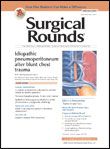Missed Opportunities in Minimally Invasive Surgery
For many procedures, minimally invasive surgery is superior to open surgery because it typically involves a few small incisions, rather than one large open cut.

For many procedures, minimally invasive surgery (MIS) is superior to open surgery because it typically involves a few small incisions, rather than one large open cut.
MIS also tends to produce improved outcomes, including fewer surgical site infections, less pain, and shorter hospital stays. However, a new study published in BMJ indicates those advantages depend largely on where a patient resides.
In the study, a surgical team from the John Hopkins School of Medicine discovered that some hospitals performed MIS less frequently than they could, due to poor division of labor and failure to direct good MIS candidates to surgeons skilled in the technique. As a result, patients assumed risks associated with open surgery more often than they should have, the authors noted.
The researchers analyzed data from the Nationwide Inpatient Sample to identify how many appendectomies, colectomies, and hysterectomies could have been performed using MIS. They also examined lung lobectomy, an operation with an unclear risk-benefit ratio for MIS.
Ideally, the projected and actual MIS rates would be similar across hospitals, but in the study, they were not. For example, the researchers found 71% of appendectomies could have been performed with MIS, but 25% of the hospitals used open operations for more than half of those procedures. When MIS was utilized, appendectomies had roughly half the complications of open appendectomies.
The hospitals that were more likely to perform MIS tended to be large urban teaching hospitals located in the Midwest, South, or West. The researchers suggested physician training might cause the regional variation, especially since physicians tend to practice close to where they trained, and surgeons rely on and prefer techniques acquired during their residencies.
